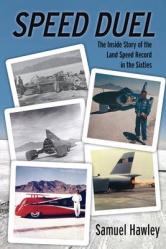 Speed Duel: The Inside Story of the Land Speed Record in the Sixties. Click image to enlarge |
By Grant Yoxon
As long as there have been automobiles, there have been men who wanted to drive cars faster than anyone else. The first official land speed record, set by Gaston de Chasseloup-Laubat of France in 1898 was just over 39 miles per hour. That record would last only one year as Camille Jenatzy would drive 65 mph in 1899. Henry Ford set a new record of 91 mph in 1904. By 1914, the record has risen to 124 mph (L.G. Hornstead).
Bit by bit, over the years, the world land speed record continued upwards. British land speed racers Malcolm Campbell and Henry Segrave would take the record over 200 mph in the early 30s, running on the flat wide beach at Daytona, Florida. But soon they outgrew Daytona and moved to the Bonneville Salt Flats in Utah, where Campbell broke through 300 mph in 1935. Then George Eyston took it to 350 mph. On the eve of the Second World War, American John Cobb took the record to 369 mph, then returned to the salt flats in 1947 and ran 394 mph. It was a record that would stand until the early 60s when the quest to be the fastest man on wheels renewed with a vigor that would see the record go past 400, 500 and then 600 mph by the middle of the decade.
Historian Samuel Hawley, a resident of Kingston, Ontario, describes the competition that involved eight men determined to be the fastest on earth – Mickey Thompson, Athol Graham, Malcolm Campbell’s son Donald, Nathan Ostich, Glenn Leasher, Craig Breedlove and Art and Walt Arfons. It is a detailed and highly personal narrative that puts the reader in the cockpit travelling at insane speeds in backyard-built contraptions that courted disaster every time they were fired up.
And this book is as much about the disasters that took place at Bonneville as it is about the success of Craig Breedlove and Art Arfons in their speed duel that took the land speed record over 600 mph.
Disaster was always the likely outcome for the next run at the record, for those who succeeded and for those who didn’t. Hawley describes – in detail that might leave a reader pale – the crashes that took the lives of Athol Graham and Glenn Leasher. Both Arfons and Breedlove, who swapped the record back and forth throughout the early 60s, crashed but survived to rebuild and run again. Others, including Thompson and Ostich, quit while they were still alive.
But two men would persist – Craig Breedlove and Art Arfons. Speed Duel is a fast-paced, fascinating and enthralling history of the rivalry between Breedlove and Arfons – and the tire companies that supported them. Both are quintessential hot rodders, working on tight budgets with few resources except their talent, ingenuity, desire and commitment. They sold sponsorships and promoted their projects, located and rebuilt discarded – but classified – US air force jets, dismantled them, repaired them and drove them to 600 mph. And both gave up much for their dream: Breedlove his marriage and Arfons his relationship with his brother and former partner, Walt Arfons.
Through extensive research including many interviews with the racers, their families and their team members, Hawley gained a deep understanding of the motivations that compel a person to continually put their life on the line so that they can lay claim to the title of being the fastest man on earth. And with a ‘you-are-there’ writing style that is equally compelling, Hawley imparts that understanding to the reader so that we too are in awe of these “ordinary men doing extraordinary things.”
Speed duel: The Inside Story of the Land Speed Record in the Sixties
By Samuel Hawley
Firefly Books
$24.95. ($16.46 at Chapters Online)
ISNN: 978-155407-633-8







 Follow Autos on Twitter
Follow Autos on Twitter
